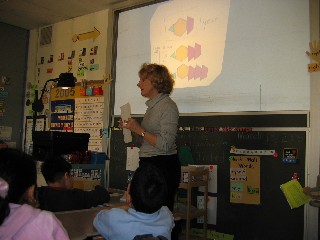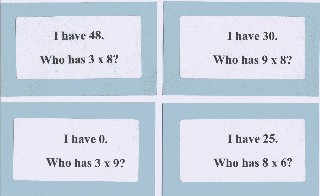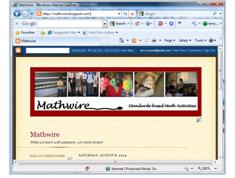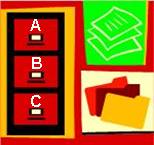
Featured Topic: Investigating Growing Patterns
|
Introduce elementary students to the concept of functions by investigating growing patterns. Visual patterns formed with manipulatives are especially effective for elementary students and allow them to concretely build understanding as they first reproduce, then extend the pattern to the next couple of stages. Finally, students explain the pattern in words and try to write a rule that works for any stage. See |

|

|
Earth Day Math ActivitiesIn a time when environmental activists are urging every American to make small changes, these PBS Mathline activities focus on mathematical investigations of earth-friendly practices, including energy usage and recycling. They provide real data and encourage students to follow the data trail through time in hopes that they will be prompted to take action.
|
Using Who Has? Decks to Practice Basic FactsOnce students have developed conceptual understanding of the basic operations they need to develop fluency with the facts. One quick way to include daily practice and motivate students to master these basic facts is through the use of the Who Has? card decks. These decks can be created for virtually any topic and frequent use as both a whole class practice or as a center activity for partners or small groups will provide facts practice in a highly-motivating format.
|

|
Mathwire Blog

Don't miss the new Mathwire Blog for the latest updates on Mathwire! The Mathwire blog will feature new activities as they are added to the Mathwire collection and it will also spotlight classic Mathwire activities, adding suggestions for classroom implementation and/or modifications to best meet the needs of varied students in a classroom.
Best of all, the Mathwire Blog format allows users to comment on the activities and add their own ideas to the mix. This should benefit all of us as we try to engage students in learning mathematics.
Check out the new  Mathwire Blog and be one of the first to become an active contributor to the Mathwire family. The Mathwire Blog replaces the old Mathwire subscription e-mail lists so that you are constantly up-to-date on Mathwire happenings.
Mathwire Blog and be one of the first to become an active contributor to the Mathwire family. The Mathwire Blog replaces the old Mathwire subscription e-mail lists so that you are constantly up-to-date on Mathwire happenings.

Mathwire Search Options
New to Mathwire.com? There are several ways to search the site for activities by Math Standard, Math Topic, or using an alphabetical search.
- See
 Searching the Mathwire.com Site for a thorough explanation of these search options.
Searching the Mathwire.com Site for a thorough explanation of these search options.
About Mathwire.com
Mathwire.com is designed to provide activities and appropriate worksheets for teachers to use in their classrooms. All activities and worksheets support the constructivist approach to learning mathematics and the NCTM Standards.
Activities: The activities on this site were developed by Terry Kawas and the teachers in districts where she has worked as a math consultant and coach or with students she has taught in college math-methods courses. The activities are classroom-tested by teachers and appropriate modifications have been made to reflect this field-testing. These activities are posted online in an effort to share quality activities and routines within the mathematics community.
Terms of Use: Teachers are welcome to download any of the activities for free use in their classrooms. No activities may be copied for use on other websites or included in commercial products without permission in writing from Terry Kawas, webmaster. Contact Terry Kawas
